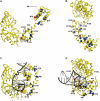Substrate-dependent millisecond domain motions in DNA polymerase β
- PMID: 22446382
- PMCID: PMC3348416
- DOI: 10.1016/j.jmb.2012.03.013
Substrate-dependent millisecond domain motions in DNA polymerase β
Abstract
DNA polymerase β (Pol β) is a 39-kDa enzyme that performs the vital cellular function of repairing damaged DNA. Mutations in Pol β have been linked to various cancers, and these mutations are further correlated with altered Pol β enzymatic activity. The fidelity of correct nucleotide incorporation into damaged DNA is essential for Pol β repair function, and several studies have implicated conformational changes in Pol β as a determinant of this repair fidelity. In this work, the rate constants for domain motions in Pol β have been determined by solution NMR relaxation dispersion for the apo and substrate-bound, binary forms of Pol β. In apo Pol β, molecular motions, primarily isolated to the DNA lyase domain, are observed to occur at 1400 s(-1). Additional analysis suggests that these motions allow apo Pol β to sample a conformation similar to the gapped DNA-substrate-bound form. Upon binding DNA, these lyase domain motions are significantly quenched, whereas evidence for conformational motions in the polymerase domain becomes apparent. These NMR studies suggest an alteration in the dynamic landscape of Pol β due to substrate binding. Moreover, a number of the flexible residues identified in this work are also the location of residues, which upon mutation lead to cancer phenotypes in vivo, which may be due to the intimate role of protein motions in Pol β fidelity.
Copyright © 2012. Published by Elsevier Ltd.
Figures









References
-
- Beard WA, Wilson SH. Structure and mechanism of DNA polymerase Beta. Chem Rev. 2006;106:361–82. - PubMed
-
- Barnes DE, Lindahl T. Repair and genetic consequences of endogenous DNA base damage in mammalian cells. Annu Rev Genet. 2004;38:445–76. - PubMed
-
- Dalal S, Hile S, Eckert KA, Sun KW, Starcevic D, Sweasy JB. Prostate-cancer-associated I260M variant of DNA polymerase beta is a sequence-specific mutator. Biochemistry. 2005;44:15664–73. - PubMed
-
- Dobashi Y, Shuin T, Tsuruga H, Uemura H, Torigoe S, Kubota Y. DNA polymerase beta gene mutation in human prostate cancer. Cancer Res. 1994;54:2827–9. - PubMed
-
- Han LP, Qiao YH, Dong ZM, Shi HR, Zhao GQ, Liu D. [Study on DNA polymerase beta gene mutation in human cervical cancer]. Zhonghua Fu Chan Ke Za Zhi. 2003;38:618–20. - PubMed
Publication types
MeSH terms
Substances
Grants and funding
LinkOut - more resources
Full Text Sources

